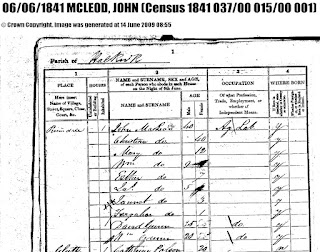Manager of Pahaua
In 1859 William McLeod left Pahaua to manage Whakapuni (which he eventually owned) and James
McLeod took over as manager. Pahaua was ‘virgin’ land, no fences, steep
hillsides, native grasses, wild dogs, isolated, no tracks or roads, no stock
apart from what they ‘drove’ in and a host of other almost insurmountable
difficulties.
Esther McLeod, sister of James, had been living at Pahaua
for some years as his housekeeper.
 |
| James McLeod |
Marriage
 |
| Catherine Sutherland |
 |
Clay house built on Ngaipu 1855 – must be Pahaua – later known as Ngaipu.
|
The first
employees on Pahaua were mostly Maori living at the pa on the station. Names
in an old diary are: Hoira, Herimiah, Paura, Hakapa, William Kelly and Robert
Wilson. Many other names of both Maori and pakeha employees are in Ngaipu.
The diary
also tells of potatoes being frequently bought from the local Maoris, being
delivered in flax kits and baskets. Wheat was packed in from the coast and
ground at the homestead. Wheat was soon grown near the homestead.
Challenges of farming at Pahaua
Chapter 9
of Sutherlands of Ngaipu tells of
some of the challenges of farming at Pahaua. From the perspective of 2019 it is
hard to imagine the hard work of managing these early settler properties.
Boundaries and fencing were just about non-existent. Wild dogs were difficult
to catch and shoot. Sheep are labour intensive at the best of times but the mustering,
tupping (rams), lambing, docking, dipping, shearing – James tied each bale with
string for a few years - wool being
packed by horses or bullock team, to the coast and put into bales there for
pickup and sale in London, must have been
incredibly challenging.
 |
| Wool bales to be loaded at Pahaua beach |
There was
all the labour that was brought in – men who had to be fed, housed, organised
for work, paid and generally looked after.
The sheep
flock was steadily being built up and from a small flock of a hundred or so
from Lyalls Bay by 1867 they had increased to 3750, being all half breeds.
There was some droving from Lyalls Bay that James McLeod was involved with.
The
cattle of Pahaua did not increase as much as the sheep. In 1871 there were 45
calves ear-marked and branded and these belonged to several members of the
family but James is not listed as an owner.
 |
| Sutherlands of Ngaipu Page 67 |
Washing the wool prior to shearing
Near the homestead there was a deep hole in the river, the
approach being down a papa ledge. The sheep were driven down this ledge and
into the river. They were kept swimming in this hole for some minutes, then
taken out on the opposite side. The method would certainly take out a lot of
dirt and grease, also make for lighter transport to the coast.
On one occasion when this work was taking place. Jim McLeod
slipped off the ledge into water 12 feet deep and which shelved up with shallow
water on the other side. McLeod could not swim. One or two men dived in to save
him, but presently they were amazed to see McLeod walk out into shallow water.
He had the presence of mind to walk along the bottom.
 |
| Sutherlands of Ngaipu Page 74 |
Fire
Bush-felling was not extensively carried out in the past,
money not being available, but fire was used to burn and clear a lot of the
fern country and scattered manuka. A fire in the sixties started by Jim McLeod
on the front hills during one very dry summer burnt for weeks and spread over
thousands of acres. Mt Adams, then in heavy timber, was all destroyed, and the
fire spread as far away as Glenburn.
Retirement
Early in 1876 James McLeod severed his connection as
manager of Pahaua, and left with his wife and young family to live in
Martinborough. He was still only a young man, 41 years of age. One reason for
his resignation was that William Sutherland, (James' cousin and son of Alexander
Sutherland who married Esther McLeod) who had been at Pahaua for several years was
now ready to carry on the management and eventual ownership of the station.The
challenges were extreme and later led to the ill-health and death of William
Sutherland. But as James had no chance of land ownership, which his brother-in-law did, there probably was not the same incentive for James to stay.
"Jim McLeod had been manager since his
brother left in 1859. Altogether he was in his uncle’s employ twenty-one years,
from 1855 to 1876. He had seen many changes, coming here when it was virgin
ground carrying no sheep or cattle, and leaving when there 7,000 sheep and
about 200 head of cattle. He did not perhaps possess the ability or energy his
brother William had, and was rather too easy going, but he was a very likeable
man." Sutherlands of Ngaipu pg 78
 |
| Part of Pahaua station (at the time the photo was taken it was called Ngaipu) |







